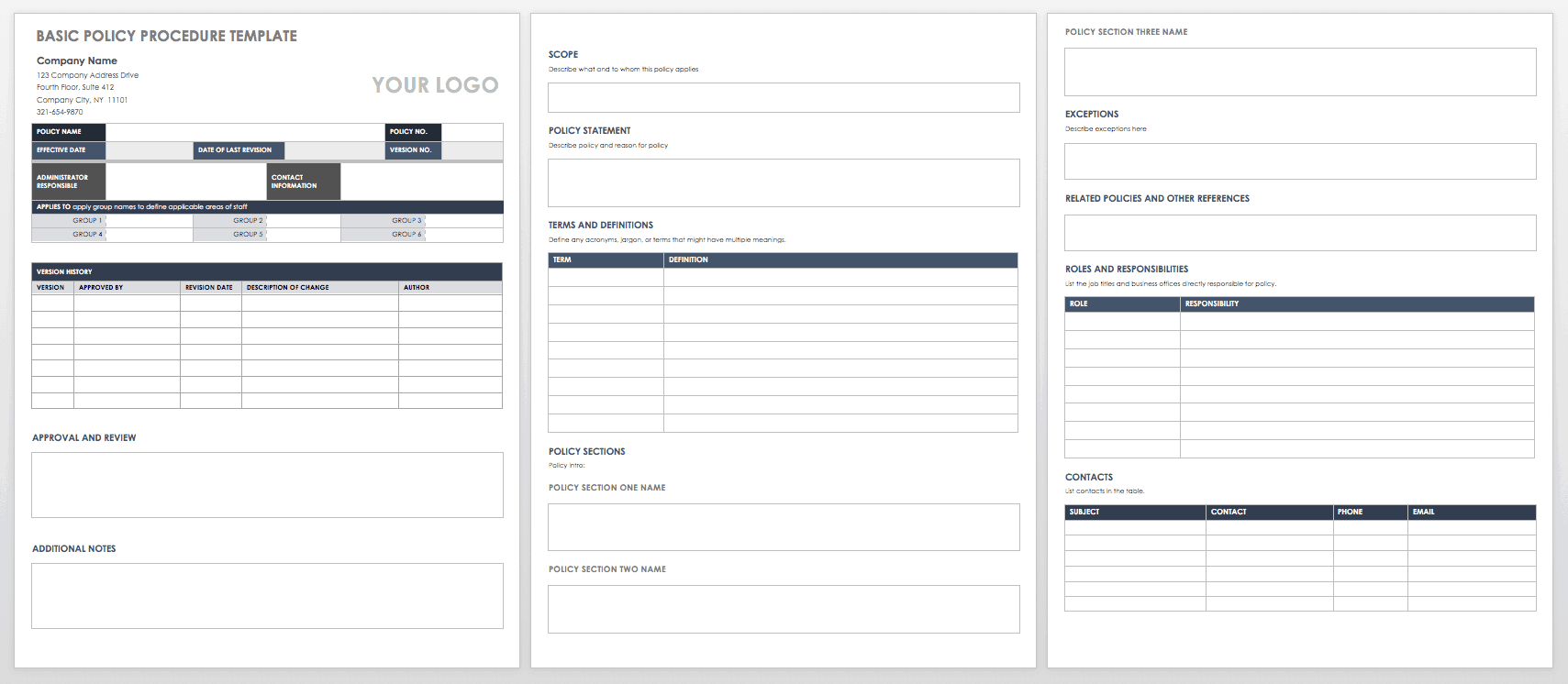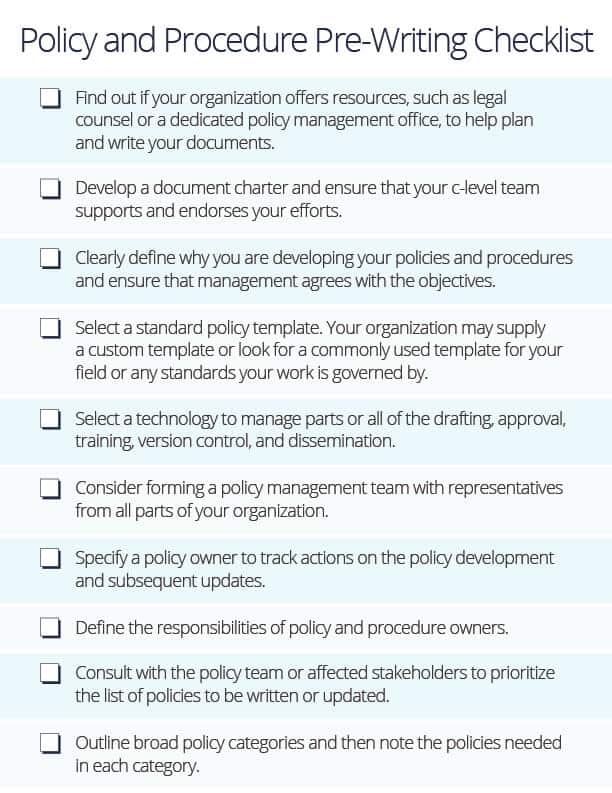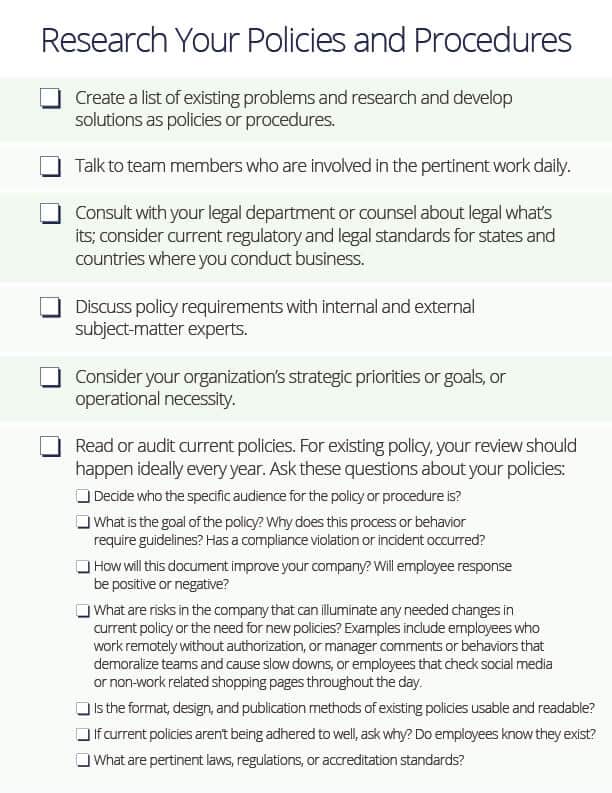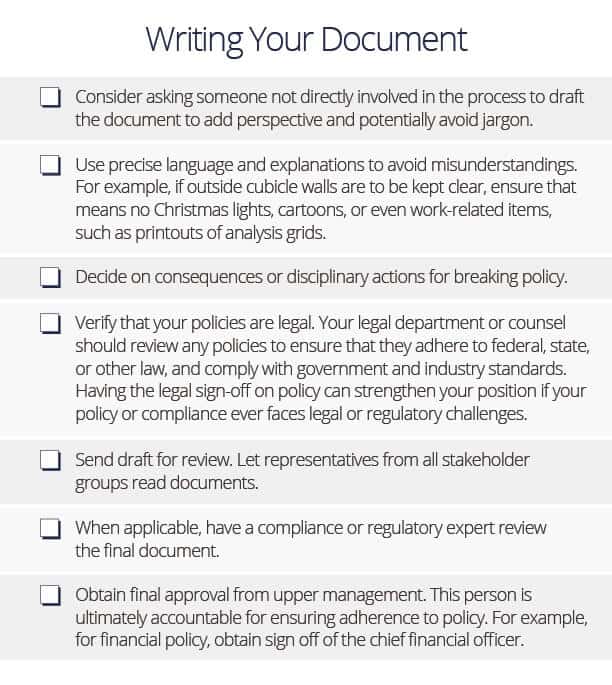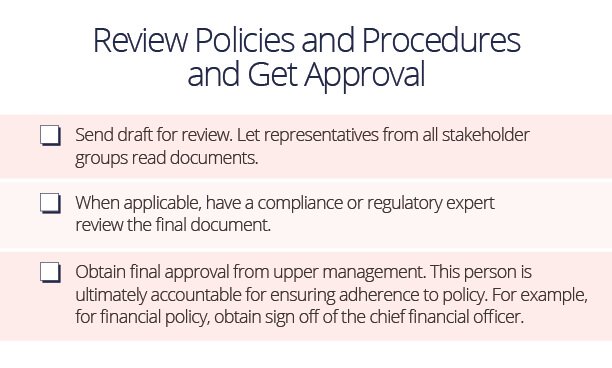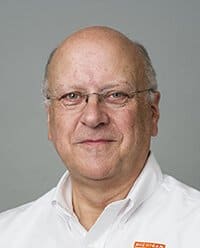What Is Meant by Policies and Procedures?
While the terms are frequently mentioned together, policies and procedures serve different roles. Policies are high-level guidelines that define the culture of an organization by shaping decisions and providing a framework for daily activities. Procedures, on the other hand, enumerate lower-level processes and provide steps your employees need to take to adhere to your policies or complete a process. Together, they can guide an organization to success through legal and regulatory compliance.
What Are Company Policies and Procedures?
Policies and procedures in a company serve to define how employees are expected to behave and to detail responsibilities of both management and employees. Company policies and procedures help to ensure that employees receive their legal and ethical entitlements. At the same time, they guarantee that an organization pays proper attention to business concerns.
Why Do We Need Policies and Procedures in the Workplace?
Policies clarify the expected behavior and output of employees — or volunteers and others, such as board members — in the context of a specific organization, which allows employers and other leaders to manage more effectively. Policies and procedures guide daily workplace activities by promoting compliance with laws and regulations, providing strategic perspective for decision making, and simplifying processes.
How Do You Formulate or Write a Policy?
Creating good policies takes time and effort, but you can increase your chances for success by remembering a few basics. Most of the work happens before you ever begin to write. Your pre-writing activities include deciding on a document focus and researching background. After writing, your documents should be reviewed, validated, and approved. Finally, you will disseminate your documents and train users in the new policies and procedures.
Before you start to write, keep the following things in mind. A policy or procedure should focus on one concept at a time. Because of the complexity and effort required to develop good policies, and because they influence the values of your office and potentially also have legal ramifications, ensure that your C-level team supports and endorses your efforts. Support the policy with employee education. Don’t expect users to simply read and retain information. As you train, give users a positive reason for learning and adapting to any new guidelines, such as achieving greater efficiency (which leads to a better organizational bottomline).
Policy Procedure Creation Workflow
To get an overview of the policy creation process, follow this workflow, and then review the checklists for each step to ensure that you’ve covered all aspects.
Download Policy Procedure Creation Workflow
Basic Policy Procedure Template
You can also use this pre-formatted template to a policy. Simply add your logo and the specific content of your policy, and customize the sections in the template to fit your needs.
Download Basic Policy Procedure Template
Policy and Procedure Pre-Writing Checklist
Much of the effort in creating policies and procedures takes place before you begin to write. This pre-writing checklist can help you find the support you need for your formal documents.
Download the Policy and Procedure Pre-Writing Checklist
Policy and Procedure Research Checklist
The key to strong policies and procedures is understanding how the people who use the documents actually perform the documented activities. Use this research checklist to gather the resources needed for a document people will want to use.
Download the Policy and Procedure Research Checklist
Policy and Procedure Writing Checklist
Once you have completed your pre-writing activities, this checklist can help you compose your policies and procedures clearly and efficiently.
Download the Policy and Procedure Writing Checklist
Policy and Procedure Review and Approval Checklist
In most organizations, policies and procedures must receive written approval. Download this checklist to streamline the document approval process.
Download the Policy and Procedure Review and Approval Checklist
Policy and Procedure Implementation Checklist
No matter how well-written or beautifully designed the document, you can’t just toss your new policies and procedures to the teams and expect them to read and understand everything. This checklist shows you how to present new policies and procedures for a lasting effect.
Download the Policy and Procedure Implementation Checklist
What Fields Can Benefit from Policies and Procedures?
Every industry, business, and organization of any size, whether for-profit or nonprofit, government or private, regulated or non-regulated, can benefit from policies and procedures. The following are some of the fields that particularly benefit from defined policies and procedures:
- HR: HR provides many of the policies that are necessary in an organization. Examples include a clear termination policy, anti-discrimination policy, and time-off policy.
- Office Management: Examples of office policies include after-hours calls, petty cash access, and supply cabinet access.
- Law Enforcement and Emergency Services: Examples include the body camera policy, drone policy, and emergency communication policy.
- Construction: Examples include the orientation and training policy, refusal of work (when employees believe a situation is unsafe) policy, and time-reporting policy.
- Education: Examples include the code of ethics policy, tenure policy, and credit-hour policy.
- Healthcare: Examples include the cell phone policy for provider offices, appointment policy, and notice of non-discrimination in health insurance policy.
- Nonprofits: These include insurance for volunteers, recruitment and selection, and expenses.
Why Does a Company Have Policies and Procedures?
Companies implement policies and procedures for a number of reasons. As Cox explains, “Any company needs to have policies which address points of conflict before they happen.” Examples include points of hand off between teams, such as when designs are transferred to manufacturing. Policies also promote conflict resolution. “Many companies have escalation procedures, but that’s after the fact,” says Cox. “A proactive stance is better.”
They communicate internally the values, objectives, requirements, and best practices throughout the company, from the C-level to independent contractors. Policies in particular also communicate the company values and objectives to potential employees, investors, customers, and the media. In general, when executed correctly, policies and procedures serve to bring order where chaos could reign. Here is why policies and procedures are crucial to your organization:
- Policies and procedures help employees maintain compliance and mitigate or even eliminate risks.
- In a regulated industry, they demonstrate legal and regulatory compliance.
- Policies provide a means to change your company culture.
- Creating policies and procedures requires spending in dollars and work hours, but what is the cost of a process failure, an injury, or damaged property?
Characteristics of Good Policies and Procedures
How do you get the best policy and procedure for your situation? Documents must meet your needs. A template can guide you to consider needed content and usable formatting, but the words and format must be customized to your situation. Following these guidelines, good documents provide the following:
- Ensure Compliance: If your organization is regulated, policies and procedures provide one means of proof that you’ve considered and implemented controls on activities.
- Increase Accountability, Training, and Responsibility: Applied correctly, policies and procedures can provide a structure for continual improvement.
- Streamline Internal Processes: Ideally, the best processes should be captured, and these provide the most efficient path for day-to-day activities.
- Help Organizations Avoid Errors and Maneuver Through Incidents and Problems: Good policies and procedures proactively anticipate problems and provide a structure for avoiding troubles or dealing with an immediate problem.
Suggested Basic Policies and Procedures
Specific policies and procedures may vary depending on the type of organization. At a minimum, you need policies for events, such as holidays or family emergencies, policies for behavior, such as attendance, absences, and harassment, and a policy governing technology, such as a BYOD policy.
Common Policies and Procedures
Attendance
Confidentiality
Equity, diversity, anti-discrimination, and anti-harassment
Financial
Health and safety
Privacy and data protection
Risk management
The table below shows some of the types of policies needed for three sample industries.
Unique to Industry | ||
|---|---|---|
Construction | Technology | Retail |
Board of directors and trustee code of conduct | Board of directors and trustee code of conduct | Board of directors and trustee code of conduct |
Hazard reporting | Bring your own device (BYOD) | Service outside of business hours |
Pitfalls of Policies and Procedures
Certainly, establishing a consistent, efficient, and effective way of doing things is desirable, and policies and procedures can help. But, documents have their limits.
This misperception led to the brick-like documents that people still dread — multiple policies with a procedure to match each, often labeled with a number instead of a real-language title and with usable content buried at the lowest layer. “A lot of people never get past the idea that documentation doesn’t make things happen,” notes Nichols. In his opinion, “Trainers and consultants still espouse a structure that wasn’t necessary and caused a bureaucracy that got in the way of people adopting a quality system.”
Nevertheless, Nichols sees a role for documentation beyond process control. Procedures and work instructions in particular can capture knowledge and real-world experience to be passed on to the next generation. In manufacturing, that institutional memory element becomes especially crucial as seasoned workers retire. “Whatever the document type,” he says, “documents are an excellent way of capturing tribal knowledge.”
Companies with Progressive Policies
Progressive company policies include such things as allowing access to personal social media during office hours, permitting work from home or remote work access, or offering paid time off (i.e., a personal pool of days off to be used for sick days or other issues as needed). Another example, demonstrated by the following companies, is generous paid maternity leave, including, of course, adoptive or foster children.
- Ironworkers: Up to six months of paid maternity leave for female employees before the birth of a baby
- Etsy: Up to six months paid parental leave for the birth of a baby
- IKEA: Up to four months paid parental leave, including for adoptive and foster parents
- Starbucks: Paid maternity and paternity leave for everyone
- Adobe: Up to four months of paid time off for the primary caregiver after a birth or time off for either parent of a newly adopted, fostered, or surrogate child
- Google: Up to 18 weeks of leave for the birth mother, extending to 22 weeks after a complicated birth. Up to 12 weeks of paid leave for primary caregivers of either gender for adoptions, fosters, and surrogate children. Seven weeks for non-primary caregivers.
- Microsoft: Three months paid parental leave, in addition to two more months for birth mothers
- Twitter: Up to five months of paid leave for birth mothers and 10 weeks for fathers
- Spotify: Up to six months of paid parental leave for all full-time employees
- Netflix: Unlimited paid leave for the first year after a birth or adoption
- Facebook: Up to 17 weeks of paid parental leave
- Reddit: Up to 17 weeks of paid parental leave
What Are the Policies and Procedures in a Childcare Setting?
Facilities supporting underage persons require their own set of documents. At a minimum, the following policies and procedures apply:
- Establishment code of conduct
- Child safety
- Operating schedule
- Parent handbook
- Employee handbook
- Disaster and emergency procedure
- Proof of national accreditation
What Are the Policies and Procedures in Health and Social Care?
Health and social care policies include guidelines to protect the health and safety of healthcare workers. They also provide standards for vulnerable citizens, such as guidelines for their healthcare, food safety in facilities, living conditions in facilities or domicile care, general safety and security, and well-being and protection during civil emergencies, such as pandemic, earthquake, or severe weather events.
Common Elements of Policies and Procedures
Although it is important to customize any documents for your situation, policy and procedure documents tend to include core elements that help identify the document and provide the information necessary:
- Clear Title: Use as few words as possible and ensure that users at any reading level can understand.
- Brief Description of the Policy: A description or introduction orients users to the scope and purpose of the policy.
- A Filing Number: A filing or tracking number may be unique to your organization. No matter what your numbering system, ensure that your title describes the content of the document.
- Key Dates: Dates include the approval date of the original document, the annual review date, and the latest version date. Dates are important for tracking versions around legislative and other updates.
- Policy Purpose: The purpose describes why the policy exists. This includes such concerns as legal and regulatory needs and problems or conflicts a policy aims to avoid.
- Policy Statement: The core of the document and usually the lengthiest part. The policy statements specify the main audience for the policy, conditions and restrictions for applying the policy, expectations, and exclusions.
- Scope: This concerns which roles or departments the policy covers.
- Responsibilities or Responsible Party: Indicate what role, department, or group must maintain the policy. Alternatively, for some policies governed by regulations, this section lists roles responsible for executing the policy.
- Definitions: Describe key terms, jargon, or ambiguous terms. Always explain key terms in a separate definitions section or at first mention in the text of your policy or procedure to ensure that everyone has the same understanding of terms. Definitions are particularly important for terms that may have multiple meanings.
- History: Knowing the history is useful for understanding changes.
- Related Documents: Attach other policies, procedures, regulatory documents, forms, and guidelines for reference.
- Search Functionality: For web-based documents, this is a policy search feature.
- Keywords: For online documents, choose keywords that relate to how a user might search for your policy.
Tools and Considerations for Creating a Policy and Procedure
If your organization must create many policies and procedures, consider purchasing a purpose-built policy management platform. Such software provides templates and a central hub for drafting, reviewing, and publishing documentation and built-in version control. Some programs also offer self-training capability, which includes recordkeeping for grades in quizzes. This is important for compliance audits.
Manual template packages are also available for sale, sometimes with software. Policy management plugins provide policy document management for common collaboration platforms. If documents are created in a word processing program, migrating them to a central location is of greater significance. Many organizations provide a web portal for policies and procedures, where users can easily search on keywords for the desired content.
No matter how the documents are created, online publishing options help to ensure that users can easily access the latest version. Binders of documents that no one can find have never been helpful.
How Do You Write a Procedure?
Many of the steps for preparing policies are echoed in the preparation of procedures. For procedures, the need to understand the process is of particular importance. When writing a procedure, keep the following things in mind:
- Decide what task needs to be detailed.
- Get background and context for each procedure.
- Observe employees in day-to-day tasks to understand current procedures.
- Interview employees who perform the tasks. You can increase their interest in and engagement with documentation by including the relevant employees during the writing process.
- Look through the audit history to understand if procedures require an update in response to non-compliance or a safety event. Recording incidents, investigating how they occurred, fixing the problem, and then regularly training and making improvements is the basis of corrective and preventive action (CAPA).
- Validate procedures in a walkthrough to ensure that users can follow them adequately.
- Ensure that wording and intent in procedures aligns with related policies, procedures, and other documents, such as forms or diagrams.
How Do You Write a Work Instruction?
Even more so than with procedures, if work instructions form part of your documentation, they must be precise and written in the users’ language. Work instructions must be specific about how a task is completed. Visual cues help learners with marginal or no reading skills, and graphics aid all users to more easily grasp and retain concepts. Keep the following things in mind when writing work instructions:
Work instructions may consist of only bullet points. Text must be scannable with clear headings.
Work instructions may include only pictures and numbers.
Some software packages for manufacturing add animation and 3D capability to help process engineers and shop floor workers better visualize instructions.
Document management systems enable reuse of validated procedures and instructions that are common to many activities, which eliminates the need to rewrite steps and the possibility of introducing ambiguities.
Language, Tone, and Style in Policies and Procedures
It’s important to write clearly, concisely, and simply. To help you achieve this, write with the reader in mind and follow these tips:
- Write to the reading level of the document users. If necessary, use only numbers, graphics, and photographs.
- Use short sentences with familiar English words and one thought or concept per sentence.
- Use must or will if something is mandatory. Avoid ambiguous words such as may or shall.
- Use plain words that are commonly understood rather than jargon. If you must use specialized terms, explain them in the text and in your glossary section.
- Use terms consistently throughout your documents.
- Write the full name for acronyms when you first use them.
- Remove extra words. For example, use to instead of in order to.
- Use positive and inclusive language. Use gender-neutral terms, such as their, not he or she, and worker, not workman.
- Use active voice rather than passive voice. For example, You must wash the dishes (active) rather than The dishes must be washed (passive).
- Use present tense. For example, say When you finish your shift, you lock the cabinets.
- Use headings that clearly identify the content of each section.
- Use evergreen information. For example, use someone@contoso.com rather than contact information for a specific individual whose contact information may change.
Download this document with tips on tone to maximize the effectiveness and readability of your policies and procedures.
Download Policy and Procedure Tone Tips
Formatting for Finding Information Fast
In addition to writing clearly, you can enhance the usability of your policies and procedures with a clear layout and optimal use of color and graphics, such as charts, diagrams, and images. Many fields and regulatory areas have predefined templates that can expedite your writing process by showing the types of content you must add. Templates usually also provide an attractive, readable format, so you don’t have to worry about layout and design. You can customize the content to suit your organization.
Here are some other formatting tips:
- Include a table of contents in Word or PDF format or with hyperlinks if online.
- Name the document clearly, so users can easily identify its purpose.
- Organize the material logically and label sections clearly, so readers can easily find the content they need.
- Make sure the links to the document from other documents and from other websites are working and up to date.
- Break the text into chunks to aid panning and scanning — include bulleted and numbered lists, graphics, charts, diagrams, well-written headings, and numbered paragraphs.
- Order topics and sections logically and use clear headings.
- Consider numbered paragraphs, which make content easier to locate in lengthy documents. However, limit organization to three levels. The first level is numbered 1, 2, 3; the second level is 1.1, 1.2, 1.3; the third level is 1.1.1, 1.1.2, 1.1.3.
- Numbered drawings and photos may convey more information than words do and may be best for certain situations.
- Use white space to avoid crowded text.
- Templates tend to have predefined sections and often subdivide sections, which can aid users in quickly finding the information they need.
- Consider using icons and colors to designate specific elements, for example, blue for links and red for caution.
If you have the a designer who can help you create icons or choose existing ones, these symbols can help direct users to appropriate sections of your documents.
Packaging Policies and Procedures
Although policies and procedures serve different purposes, they can be combined in one document, particularly when both the policies and accompanying procedures are short. Some believe, however, that their different roles are a good reason to separate then into two documents. Ideally, you should update procedures (and especially work instructions) frequently to reflect innovations in process or address problems and incidents. You can revise policies less frequently.
What Is the Difference between a Policy and a Procedure and a Process and a Work Instruction?
To have an efficient and compliant organization, you need all three p documents — policies, procedures, and processes — plus something else: work instructions. The terms policy and procedure are sometimes confused and used interchangeably, whereas they serve different purposes.
- Policy: Policies are the guidelines that oversee organization activities, such as green manufacturing or a smoke-free environment. Policies describe legal, regulatory, or internal standards for required behavior and activities. Policies and procedures, depending on the size of the organization, may fill a volume or more or may consist of simply a handful of short paragraphs.
Cox sees policies as “more shades of grey,” as guidelines that senior and middle management use. “Policies require a lot of interaction between the senior leadership team and upper middle management,” he explains. “Policies need to be reviewed every so often to make sure they are serving the needs of the organization and require flexibility around them for revisions,” he adds.
As they define company culture, policies also communicate strategy, such as green manufacturing. Policies help reduce risk and ideally create an environment that encourages improvement. Although policies may reference laws and regulations, they do not reiterate laws and standards. Instead, they define a particular application of those legal or regulatory guidelines. - Procedures: Procedures guide middle management and create overarching structure for process instructions and work instructions, which provide production tasks and steps for supervisors, individual contributors, and workers. Procedures are used by supervisors, industrial engineers, or the individual worker. Procedures describe the process at a higher level and may be in a binder. They depict a repetitive task or process. In manufacturing, procedures describe a series of steps or tasks and contain work instructions. In general, procedures describe what to do, when to do something, and who does it.
“Procedures are very specific and need to be very black and white without a lot of need for interpretation,” says Cox. But, while the content may provide precise descriptions, the descriptions may change more frequently. “At the work instruction level, they may change every day or every few days as they [employees] attempt to get the best result for the customer.” - Processes: Processes describe what the organization does and who does it. They explain how procedures fit together to create deliverables or accomplish goals and objectives.
- Work Instructions: Work instructions are the lowest level of document used by supervisors, individual contributors, or workers, with descriptions of how to complete a specific step. Work instructions are granular, short documents, often of only one page, a single paragraph, or a set of bullet points, and frequently include many visual cues, such as colors, graphics, or photographs.
Work instructions are intended to be precise documents that allow interchangeable staff in high turnover situations to train and achieve optimum performance in one hour or less. As Cox describes them, “Work instructions provide what is necessary to train a person as fast as possible or even self-training.” These documents should be at the worksite, so the trainer, and eventually the worker, can refer to them. An essential part of work instructions are checklists, which he says can be as simple as a photo with items of interest circled.
Download Policy and Procedure Process Work Instruction Checklist
Successfully Implement Your Policies and Procedures with Automated Business Processes in Smartsheet
Empower your people to go above and beyond with a flexible platform designed to match the needs of your team — and adapt as those needs change.
The Smartsheet platform makes it easy to plan, capture, manage, and report on work from anywhere, helping your team be more effective and get more done. Report on key metrics and get real-time visibility into work as it happens with roll-up reports, dashboards, and automated workflows built to keep your team connected and informed.
When teams have clarity into the work getting done, there’s no telling how much more they can accomplish in the same amount of time. Try Smartsheet for free, today.


